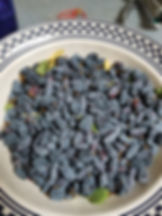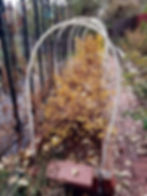Honeyberry: The Delicious Blue Honeysuckle
- Bryan Prud’Homme
- Aug 25, 2022
- 4 min read
By Bryan Prud’Homme:

Imagine a beautiful, pest-resistant, non-invasive shrub that grows vigorously in our Colorado Front Range alkaline clay soil, largely unaffected by late spring freezes, and produces beautiful dark blue/purple tart to very sweet berries - the earliest fruit of the season in most gardens. That plant is the Honeyberry. These shrubs, called hascaps in Japan, belong to the Lonicera family, related to the common honeysuckle. They originate chiefly in Siberia and the northern islands of Japan to Russia (the Kuril), and are generally hardy to -40°F or more. The University of Saskatchewan Extension, Berries Unlimited in Arkansas, and the late Maxine Thompson in Oregon, are some that have developed and distributed improved honeyberry cultivars.
Honeyberries, while blue, do not taste anything like blueberries. The fruit ranges from tart, to sweet-tart, to very sweet. Many are Russian cultivars that blossom early or Japanese cultivars that blossom later. Most others are crosses of Russian, Japanese, and sometimes Kuril types.

I first planted five different honeyberries in Spring 2016. Few were available and there was little information about them. Those I had purchased online arrived in small pots. Once planted, in early and late spring, they began growing new wood (and roots and buds) but struggled in the highest summer heat. Soon they appeared to be dead; the leaves turned black and fell off. But they had simply gone dormant and the following spring they grew vigorously. Especially if coming from different USDA zones, honeyberries might arrive looking dying or dead, but keep watering them as usual. The easiest way to avoid early full dormancy is to plant them in fall, after the hottest days.
In my garden, honeyberries blossom in 4 groups: early, early-mid, mid, and late. To ensure fruit production you must choose cultivars in the same group but not too closely related. (Information usually provided by nurseries). They have complete blossoms and will cross pollinate with others in the same blooming group, but not with a cultivar that is too closely related.

Successfully pollinated and fruit set-on, my first five plants provided the first fruit of the season in my garden, ripening weeks before the strawberries. But the berries tasted “skunky” and numbers were unimpressive. After fruiting, all showed signs of early dormancy with leaves becoming dull. Then in late fall they turned a beautiful golden yellow. Fortunately, I didn’t dig them out.
By the third year the fruit were larger, more numerous, and tart without that skunky flavor – very suitable for baking and preserves. My patience was paying off. I prepared another bed for some newer, sweeter cultivars that had become available. The plants arrived in a variety of ages, sizes, and conditions. Some looked dead on arrival and most were very small. One came as small bare root twigs with tiny roots wrapped in wet paper towels. By the fourth year, the fruit from the oldest plants was larger, much more numerous, and sweet enough to eat with no hint of skunky or overly tart flavor. The clear lesson was that some honeyberries need 3 to 5 years or more for the fruit to develop good flavor. The mature plants’ fruit took on an interesting, more focused, unique flavor unlike any berry I had ever tasted.
Tips for Selecting & Growing Honeyberries
• Each cultivar has its own taste, yield, growth habit, and size so research for desired traits before purchasing.
• The fruit of upright cultivars is easiest to harvest, while those with a low to ground, sprawling, squatty shape are more difficult.
• Birds, especially robins, will quickly clean out your honeyberries if not netted. So far, rabbits haven’t fed on mine but hardware cloth cages will protect young, tender plants.
• Honeyberries have shallow root systems. Take care when cultivating root areas.
• Plant at least 2 (3 is better) in the same blooming group that aren’t closely related to ensure good fruit production.
• It’s easiest to establish young plants in the fall. Larger plants with more roots can be planted in early spring with regular irrigation.
• They will grow in unimproved clay soil but working compost and organic material into the soil gives best results.
• In much of Colorado, honeyberries can be successful in full sun and in part shade. In hot areas, morning sun with afternoon shade and fall planting ensure better results.
In early 2020, I read that honeyberry plants will blossom in 25° F weather and the blossoms will tolerate temperatures below 20°F. Knowing that these very cold hardy plants are generally successful in USDA zones 2-7, I decided to test their hardiness by not covering them during any late spring freezes.
Unfortunately, two late, record-setting cold spring freezes damaged the plants. The lowest survival temperature for the blossoms and new tender growth turned out to be 11°F. But none of the shrubs or any old wood were critically damaged. Should I plant honeyberry shrubs knowing that hard late freezes can potentially damage my yield? Yes! In some years I’ve had no apples, cherries or peaches either.
My garden is a traditional suburban lot. I planted my honeyberry shrubs closer together than recommended because variety is more Important to me than maximum yield from any one plant. Planted 3-4 feet apart, the oldest honeyberry bushes are definitely forming a hedge. For maximum yield, 5 -7 feet spacing is recommended. For my purposes, the variety of honeyberry flavors I now have outweighs the possibly diminished yield. Others might prefer to maximize yield with fewer plants.
To date I have planted a grand total of 38 honeyberry cultivars. Based on my growing experience the late to very late blooming cultivars, many 100% Japanese, produce the best tasting, sweetest fruit—and in just two years. None had to go through overly tart or skunky stages. It took leaps of faith and much patience but I can now share my short list of top cultivars: Blue Banana, Giant Hearts, Aurora, Honey Gold, and Blue Treasure. (There’s a longer list too.) Enjoy!
Bryan Prud’Homme is a Master Gardener who lives in Louisville, CO where he has tended his garden for 34 years. He loves Honeyberries!




